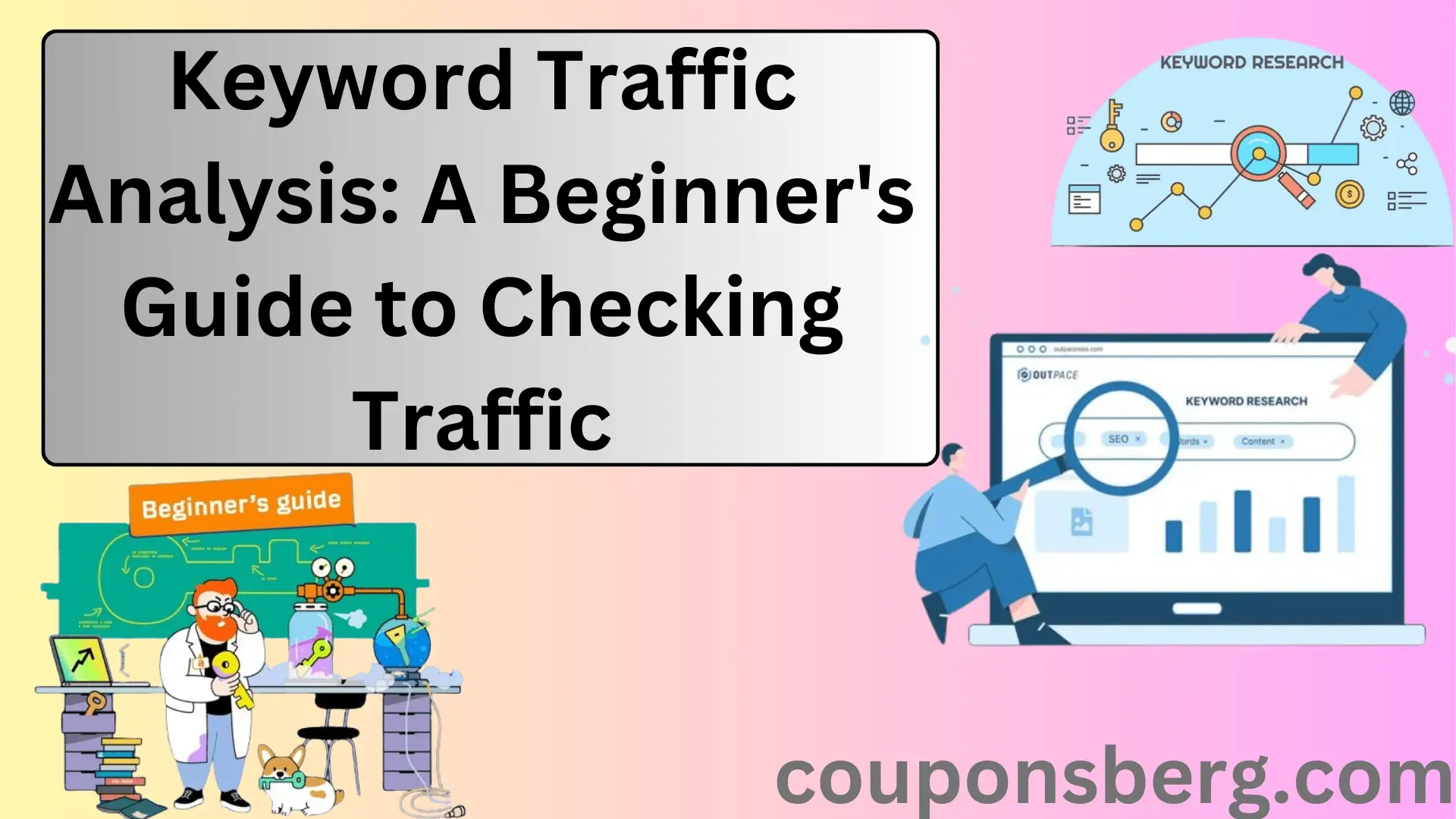Keyword Traffic Analysis: Understanding how people find your website and the search keywords that bring in the most traffic requires a thorough understanding of keyword traffic analysis. To assist you in getting started with keyword traffic tracking, below is a beginner’s guide:
What Is Keyword Traffic Analysis?
The process of analysing website traffic resulting from users typing search engine queries is known as keyword traffic analysis.
For instance, the Google search engine returns relevant results when someone types in “cooling pillow.” Keyword traffic, also referred to as “keyword search traffic,” is the inbound traffic that occurs when a searcher clicks on your result.

Analysing keywords that may drive traffic is known as keyword traffic analysis. determining which ones presently provide visitors to your website as well.
Traffic analysis is made quicker and simpler by SEO tools like Semrush’s Keyword Overview. Through offering insightful information on the frequency of a specific term’s monthly searches (also known as keyword volume). additionally, the difficulty (keyword difficulty) of ranking for the keyword.

The Importance of Keyword Traffic
Finding the source of your keyword search traffic will help you determine which terms are crucial. You may optimise your content for these terms after you know which keywords bring in the most traffic.
The following are possible advantages of this:
- Higher rankings in search engines
- More pertinent website users
- A rise in leads and revenue
Examine keyword traffic to figure out how people are finding your website. as well as which terms generate the most traffic.
Determining the purpose of a search, often known as keyword intent, is also essential. because it ensures that your content is relevant to the people you want to reach. and convert visitors into possible clients.
Four categories of keyword intent exist:
- Informational: The user is trying to find out more details.
- Navigation: The user is trying to find a certain website or page.
- Commercial: The user is looking up a company, item, or service.
- Transactional: The user want to purchase a certain good or service.
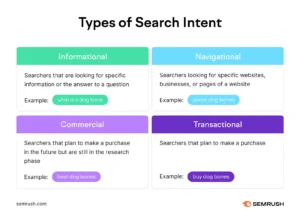
How to Conduct a Keyword Traffic Analysis
Check Estimated Search Traffic
To obtain possible traffic numbers, check the predicted search traffic for specific keywords. Next, order the keywords according to their potential to bring relevant site visitors. This may increase the likelihood that the proper people will find you.
Assume you market dog chow that is 100% natural. Utilise our Keyword Overview tool to investigate this keyword’s possible traffic.
Here’s how to do it:
Put the term into the utility. We utilised “all natural dog food” in our example.
Next, choose the nation.
Press “Search.”

A dashboard overview including volume, keyword difficulty, worldwide volume, and further keyword data will be displayed to you.
The volume for “all natural dog food” is 2,900. Instead of predicted traffic, this provides you the average monthly search volume.

Go to the “SERP Analysis” section by scrolling down.
The first URL (on onlynaturalpet.com) is ranked #1 in this table for the term “all natural dog food.” The second URL is ranked #2 on dogfoodadvisor.com. And so forth.
The amount of traffic that each page receives from its target keywords is displayed in the “Search Traffic” column.
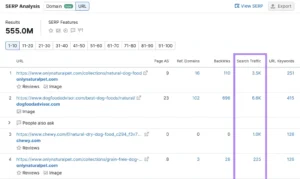
Click the blue number in the “Search Traffic” column to view the estimated page traffic for the specified keyword.

You can access the Organic Research study by doing this. Go to the “Organic Search Positions” section by scrolling down.
Search for the term. Here, we can observe that “all natural dog food” ranks #1 for the keyword and produces an anticipated 382 site visits each month.
Therefore, even though there are 2,900 searches for the phrase, only 382 people view the top result each month. or around 13% of that amount.

To view the estimated keyword traffic for additional websites that rank for the same keyword, go back to the “SERP Analysis” section. Generally speaking, a site receives more visitors the higher it ranks.
Analyze Competitor Keyword Traffic for Ideas
Examine the keywords used by your rivals to find out what subjects and phrases they value. and how they respond to the search intent of their audience.
After that, make new content that ranks higher than theirs using this information. and enhance already-existing pages.
Imagine you wish to discover the terms that bring visitors to a website owned by one of your rivals. You must examine a URL because traffic generated by keywords is traffic to a website. This could be a page, domain, or subdomain.
To find traffic estimations and rival keyword ideas, use couponsberg’s Organic Research tool.
In the tool, type in the competitor’s domain, select a nation, and press “Search.”

A dashboard displaying a summary of keyword rankings and other traffic metrics will be visible to you.
Navigate to the “Positions” page to view the domain’s ranking keywords.

The tool offers a 30-day rankings trend, a table of keywords the website ranks for, and a summary of traffic and keyword statistics.

Go to the “Organic Search Positions” section by scrolling down.
The keywords that bring visitors to the competitor’s website are displayed here. Sort by Keyword Difficulty, Position, Intent, Volume, and more.
For every given keyword, the “Traffic” column shows the approximate monthly traffic that the keyword brings to the domain.
In this case, the World Wildlife Fund website receives an estimated 40,900 visitors each month from the phrase “sloth.”

If this were a rival company, you may write content with this term in mind. or edit already-written material. Delivering greater value than your rivals is crucial. it necessitates comprehending the purpose of the search. as well as producing top-notch material.
Check Your Keyword Traffic in Google Search Console
Go to Google Search Console (GSC) to monitor Google keyword traffic.
GSC is a free utility that allows you to:
- Track the performance of your website in Google searches.
- Use Google to find out which keywords bring visitors to your website.
- Examine the terms you want to target.
- Find new keywords to focus on.
- Examine keyword performance to find areas that could be improved.
Go into GSC and choose your site from the property drop-down menu to access this information.
Next, select “Search results” from the menu on the left.
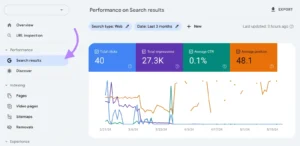
This report shows various metrics related to searches:
- Total number of clicks
- Overall perceptions
- Average click-through rate, or CTR
- Position average
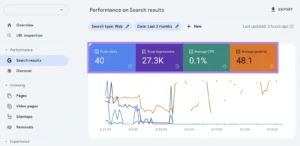
Navigate beyond the line chart to access the section labelled “Top queries.” This is where you can view the search terms that have linked to your website. as well as clicked through from the SERP.
Here are some examples of the most popular searches for an auto shop.
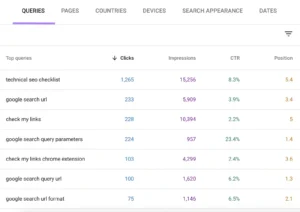
Consider the most popular query: “auto repair shop.” It led to 19 clicks to the store’s website in a span of three months. This indicates that there are roughly six visits to the website each month for this query (19 / 3 = 6.3).
Review your most important questions. Additionally, mention the terms you want to focus on.
Make a note of the keywords that have a lot of impressions and click-through rates first. These are probably important to target as they are already driving traffic to your website.
Even with low CTRs, keywords have value. Keep an eye out for terms with high impressions but poor CTRs. This could indicate that although you’re appearing in search results, no one is clicking. Or your ranking isn’t high enough. To optimise your content, focus on these.
Observe the keywords that you rank for even though the material on your pages doesn’t contain them. You can raise your pages’ rankings by optimising them for these terms.
We advise keeping an eye on the performance of your list; we’ll go over that in the next section.
Track Positions and Estimated Keyword Traffic
Use our Position Tracking tool to monitor ranks and predicted keyword traffic.
In Semrush, if you already have a property set up, select “+ Create project” from the tool. Not established one yet? Enter your domain in the tool’s field and select “Set up tracking.”

Next, select the device, search engine, and location that you would like Semrush to monitor. We advise you to leave “Google,” “Desktop,” and “United States” as the defaults if you’re just getting started.
Click “Continue To Keywords” after that.

You can import your keyword list from another source or manually enter it.
Select “Campaign Keywords” by clicking. Click “Start Tracking” after that.

Overall metrics are displayed on the dashboard. comprising average position, projected traffic, and visibility. and an overview of your website.
To display anticipated traffic and more keyword information, click the “Overview” tab.

Go to the “Rankings Overview” section by scrolling down.
The monitored keywords are included in the table. In addition to their rankings, volume, expected traffic, and other details.
For instance, this example site receives an estimated 897.87 visits per month from the search term “casserole recipes.”
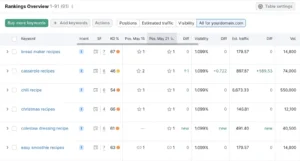
Analyze Your Keyword Traffic to Improve Your Rankings
There are several advantages to knowing which keywords bring people to your website. assisting you in finding keyword opportunities, raising your search engine ranks, and drawing in more traffic.
Determine which keywords bring in the most visitors to your website to begin your keyword traffic study. Utilise a performance monitoring tool such as Position Tracking. and immediately receive updates on any changes. such as position, visibility, and predicted traffic.
*>GET MORE INFORMATIONS VISIT ON …..Couponsberg.com **
FAQs : Keyword Traffic Analysis
1. What is keyword traffic analysis?
Keyword traffic analysis is the process of finding and studying the search terms (keywords) that people use to find your website. It helps you understand what people are looking for and how your website can attract more visitors.
2. Why is keyword traffic analysis important?
Keyword traffic analysis is important because it helps you:
- Improve your website’s search engine ranking.
- Create content that matches what people are searching for.
- Understand and outperform your competitors.
- Make your website more user-friendly and relevant.
3. What tools can I use for keyword traffic analysis?
Several tools can help you analyze keyword traffic, including:
- Google Analytics: Tracks how visitors find and use your website.
- Google Search Console: Shows which keywords bring visitors to your site.
- SEMrush: Provides detailed keyword data and competition analysis.
- Ahrefs: Offers keyword research and ranking information.
- Moz: Provides keyword research and rank tracking tools.
4. How do I find keywords for my website?
You can find keywords for your website by:
- Using keyword research tools like Google Keyword Planner, SEMrush, or Ahrefs.
- Looking at the search terms people use to find similar websites.
- Analyzing your website’s current traffic data in Google Analytics and Search Console.
5. How do I analyze keyword performance?
To analyze keyword performance:
- Check search volume: Find out how many people are searching for a keyword.
- Look at competition: See how many other websites are trying to rank for the same keyword.
- Evaluate click-through rates (CTR): Determine how often people click on your site when it appears in search results.
- Monitor ranking positions: Track where your website ranks for specific keywords over time.
6. How can I improve my website’s ranking with keyword traffic analysis?
To improve your website’s ranking:
- Use relevant keywords in your content, titles, and meta descriptions.
- Create high-quality, useful content that answers users’ questions.
- Optimize your website’s structure and navigation for better user experience.
- Build backlinks from other reputable websites.
7. How often should I conduct keyword traffic analysis?
You should conduct keyword traffic analysis regularly, such as:
- Monthly: To stay updated with the latest trends and performance.
- Quarterly: To make bigger adjustments to your content strategy.
- Whenever you notice significant changes in website traffic or search engine rankings.
